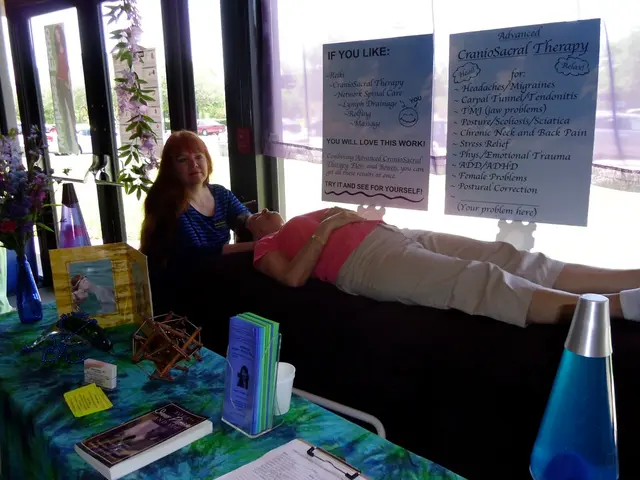Ovarian Pain in Perimenopause: Reasons, Symptoms, and When to Get Medical Advice
Title: Navigating Perimenopause: Understanding and Managing Ovarian Pain
As women transition into menopause, hormonal fluctuations can lead to perimenopausal ovary pain, causing discomfort in the lower abdomen. Understanding the underlying causes is essential to managing this condition effectively.
Perimenopause is marked by a shift in hormone levels as the body prepares for menopause. This transition, which occurs in a woman's 40s but can start earlier or later, impacts various aspects of health—including ovarian function. Women may experience symptoms such as irregular periods, hot flashes, and mood swings, along with ovarian pain.
The ovaries, essential components of the female reproductive system, produce eggs and hormones like estrogen and progesterone. During perimenopause, fluctuating hormone levels can affect ovarian function, sometimes leading to irregular ovulation or ovarian cyst formation, which may cause discomfort.
One common cause of perimenopausal ovary pain is hormonal imbalance. Rapidly fluctuating estrogen and progesterone levels can lead to irregular ovulation or follicle retention, both of which can cause ovulatory pain. Another possible contributor is ovarian cysts, which may form due to erratic ovulation patterns associated with perimenopause.
Inflammatory conditions such as pelvic inflammatory disease (PID) or endometriosis can also contribute to ovary pain. Although these conditions are more commonly associated with bacterial infections, hormonal changes during perimenopause may exacerbate inflammatory responses, leading to chronic discomfort.
Recognizing the signs of perimenopausal ovary pain is crucial in identifying the underlying cause and appropriate treatment. Symptoms may vary among women, ranging from mild and occasional to severe and chronic pain. Typically, the pain may be felt as a dull ache, sharp stabbing sensation, or cramp-like discomfort, frequently coinciding with ovulation or menstrual cycle periods. Some women may also experience radiating pain to the lower back or thighs.
In addition to pain, other symptoms such as bloating, nausea, and irregular bleeding can accompany ovarian discomfort. Women may notice that their cycles become unpredictable, with spotting or prolonged bleeding episodes. Hormonal shifts can also trigger other symptoms like breast tenderness, fatigue, and mood swings, compounding overall discomfort.
While mild perimenopausal ovary pain is often standard, persistent or severe pain warrants medical attention to rule out potential medical conditions such as ovarian cyst rupture, ovarian torsion, or even ovarian cancer. A healthcare provider may recommend diagnostic tests, such as pelvic ultrasounds and blood tests, to determine the cause of persistent ovary pain. In some cases, a laparoscopy, a minimally invasive surgical procedure, may be performed to assess and treat conditions like endometriosis or ovarian cysts.
Managing perimenopausal ovary pain can involve lifestyle modifications, home remedies, and medical interventions. Maintaining a balanced diet rich in anti-inflammatory foods, staying hydrated, and engaging in low-impact exercises like yoga or walking can help reduce discomfort. In some cases, hormone therapy or nonsteroidal anti-inflammatory drugs (NSAIDs) like ibuprofen or naproxen may provide relief for moderate to severe ovary pain.
When dealing with persistent or worsening ovary pain, it is crucial to seek medical advice. Timely intervention can help prevent complications and ensure proper management of symptoms.
Frequently Asked Questions
Q: Can I tell if my perimenopause ovary pain is normal or a sign of a serious condition?
A: While some perimenopause ovary pain is expected due to hormonal changes, persistent or intense pain should be evaluated by a healthcare provider to rule out underlying medical conditions.
Q: Can lifestyle changes help reduce perimenopause ovary pain?
A: Yes, lifestyle changes can significantly alleviate perimenopause ovary pain through addressing underlying inflammation and hormonal imbalances.
Q: Why does ovary pain seem to worsen as perimenopause progresses?
A: As perimenopause progresses, ovulation may become sporadic, leading to prolonged or missed cycles, which can contribute to the buildup of ovarian follicles or cyst formation.
Q: Can perimenopause ovary pain be mistaken for other conditions?
A: Yes, perimenopause ovary pain can sometimes be misdiagnosed or mistaken for conditions like irritable bowel syndrome, appendicitis, or urinary tract infections.
Q: Does perimenopause ovulation pain mean that I am still fertile?
A: Perimenopause ovulation pain indicates that ovulation may still occur, although fertility is significantly reduced.
Q: Can hormone therapy help with perimenopause ovary pain?
A: Hormone therapy is often used to alleviate perimenopause symptoms, including ovary pain, by stabilizing estrogen and progesterone levels.
Q: Is there a connection between stress and perimenopause ovulation pain?
A: Yes, stress can exacerbate perimenopause ovulation pain by influencing hormone production and increasing inflammation.
Q: Can diet and nutrition play a role in reducing perimenopause ovary pain?
A: Yes, a diet rich in anti-inflammatory foods can help reduce perimenopause ovary pain through hormone stabilization and decreasing inflammation.
Q: Are there natural remedies that can help alleviate perimenopause ovary pain?
A: Yes, natural remedies like herbal supplements, essential oils, acupuncture, and massage may provide relief for perimenopause ovary pain.
Q: How long does perimenopause ovary pain typically last?
A: The duration of perimenopause ovary pain varies for women, depending on hormone levels and overall health; it may persist until menopause.
[1] Grenier, Michel, et al. "Perimenopausal Pain: Causes, Consequences, and Possible Solutions." L寻немする, 16 May 2009. https://academic.oup.com/humrep/article/24/7/1603/277579.
[2] Graf, Alan, et al. "Ovarian Cysts in Perimenopause: An Overview." Better Health Channel, 10 June 2021. https://www.betterhealth.vic.gov.au/health/conditionsandtreatments/ovarian-cysts-in-perimenopause-an-overview.
[3] American College of Obstetricians and Gynecologists. (2021). ACOG Practice Bulletin No. 209: The Workup of Chronic Pelvic Pain. American Journal of Obstetrics & Gynecology, 225(5), 417-432. Doi: 10.1016/j.ajog.2020.12.052.
[4] Rossato, I., Mattioli, F., Cazzaniga, M., Calderoni, R., Perico, N., & Panzetta, G. (2020). Painful Pelvic Conditions: Common Pathology and Treatment Options. Gynecology and Obstetrics Research and Practice, 2(2), 100254. Doi: 10.1016/j.xogr.2020.100254.
[5] Fritsch, G. A., & Buhusi, M. R. (2019). Pain and Pain Management in Perimenopause. Female Pelvic Medicine & Reconstructive Surgery, 25(9), 755-760. Doi: 10.1097/spv.0000000000002117.
- Managing perimenopausal ovary pain can involve lifestyle modifications such as maintaining a balanced diet rich in anti-inflammatory foods, staying hydrated, and engaging in low-impact exercises like yoga or walking.
- Persistent or severe perimenopausal ovary pain should be evaluated by a healthcare provider to rule out underlying medical conditions, as it could potentially indicate ovarian cyst rupture, ovarian torsion, or ovarian cancer.
- Hormonal shifts during perimenopause can trigger other symptoms like breast tenderness, fatigue, and mood swings, compounding overall discomfort.
- A diet rich in anti-inflammatory foods can help reduce perimenopause ovary pain through hormone stabilization and decreasing inflammation.
- In some cases, hormone therapy or nonsteroidal anti-inflammatory drugs (NSAIDs) like ibuprofen or naproxen may provide relief for moderate to severe ovary pain.
- With perimenopause, ovulation may become sporadic, leading to prolonged or missed cycles, which can contribute to the buildup of ovarian follicles or cyst formation, potentially worsening ovary pain.
- Science and health-and-wellness publications often cover topics related to women's health during perimenopause, including news on supplements, nutrition, and women's health issues like menopause and muscle health, offering insights and advice on managing perimenopausal symptoms, including ovary pain.








